Detection and Driving Factor Analysis of Hypoxia in River Estuarine Zones by Entropy Methods
Abstract
1. Introduction
2. Materials and Methods
2.1. Study Area
2.2. Anomaly Detection Method Based on Wavelet Analysis and the Temporal Entropy Index
2.2.1. Wavelet Analysis
2.2.2. Temporal Entropy Index
- Baseline condition: If all DO values within the cell remain below Ct, Gt and Rw equal 0, indicating normal water quality;
- Warning phase: Rw > 0 signals threshold exceedance, triggering an anomaly alert;
- Critical action: Sustained Rw > 0 over consecutive intervals confirms an anomaly;
- Recovery: When Rw ≤ 0 and DO values stabilize below Ct, normal operations resume.
2.3. Driving Factor Analysis Method Based on Pearson Correlation Coefficients and Transfer Entropy
2.3.1. Pearson Correlation Coefficients
2.3.2. Transfer Entropy
3. Results
3.1. Anomaly Detection in the Hypoxia Phenomenon
3.1.1. Hypoxia Event Identification by CWT
3.1.2. Hypoxia Event Identification by Temporal Information Entropy
3.2. Analysis of Driving Factors of Hypoxia Events
3.2.1. Water Temperature
3.2.2. Turbidity, Ammonia, and Total Nitrogen
3.2.3. Correlation Analysis Between Hypoxia Events and WWTP Pollution Loads
4. Discussion
4.1. Comparison and Combination of Anomaly Detection Methods
4.2. Driving Factors of Hypoxia Events and the Lag Effect of Factors
4.3. Potential Prediction of the Estuary Minimum DO
5. Conclusions
- Two anomaly detection methods, wavelet analysis and the temporal information entropy index, were applied to identify hypoxia events in the SRE. The results showed that wavelet analysis excels at detecting pattern anomalies in time-series data, while the temporal entropy index method focuses on identifying anomalies based on thresholds, revealing that these approaches can target qualitative and quantitative anomaly detection, respectively. The coupled anomaly detection framework combining two anomaly detection methods can establish a complementary “high-frequency localization and low-frequency assessment” paradigm, significantly enhancing the identification capability for hypoxia events. The temporal information entropy index demonstrated robust performance in threshold-based anomaly detection.
- In the Shenzhen River, while temperature occasionally contributed to hypoxia events, it was not the decisive driving factor. Turbidity and total nitrogen (TN) exhibited significant negative correlations and temporal lags with DO. Their respective lag times influencing low DO events were 36 h and 72 h, with Turbidity demonstrating a stronger driving force than TN.
- The pollution loads of BOD, SS, and TN from upstream WWTPs showed significant negative correlations with the daily minimum DO levels at the estuary in 2023, with Pearson correlation coefficients (r) of −0.32, −0.76, and −0.32, respectively. Compared to 2022, these correlations intensified notably, indicating improved water quality in the Shenzhen River after remediation measures in 2023. This enhancement suggests a growing influence of upstream pollutant loads on estuarine hypoxia.
Supplementary Materials
Author Contributions
Funding
Data Availability Statement
Acknowledgments
Conflicts of Interest
References
- Grantham, B.A.; Chan, F.; Nielsen, K.J.; Fox, D.S.; Barth, J.A.; Huyer, A.; Lubchenco, J.; Menge, B.A. Upwelling-driven nearshore hypoxia signals ecosystem and oceanographic changes in the northeast Pacific. Nature 2004, 429, 749–754. [Google Scholar] [CrossRef] [PubMed]
- GB 3838-2002; Environmental Quality Standards for Surface Water. China Environmental Press: Beijing, China, 2002.
- Liu, S.; Chen, Q.; Hou, C.; Dong, C.; Qiu, X.; Tang, K. Recovery of 1559 metagenome-assembled genomes from the East China Sea’s low-oxygen region. Sci. Data 2024, 11, 994. [Google Scholar] [CrossRef]
- Engle, V.D.; Summers, J.K.; Macauley, J.M. Dissolved Oxygen Conditions in Northern Gulf of Mexico Estuaries. Environ. Monit. Assess. 1999, 57, 1–20. [Google Scholar] [CrossRef]
- Schonfeld, A.J.; Ralph, G.M.; Gartland, J.; St-Laurent, P.; Friedrichs, M.A.M.; Latour, R.J. Hypoxia influences the extent and dynamics of suitable fish habitat in Chesapeake Bay, USA. Mar. Ecol. Prog. Ser. 2024, 748, 117–135. [Google Scholar] [CrossRef]
- Conley, D.J.; Carstensen, J.; Aigars, J.; Axe, P.; Bonsdorff, E.; Eremina, T.; Haahti, B.-M.; Humborg, C.; Jonsson, P.; Kotta, J.; et al. Hypoxia Is Increasing in the Coastal Zone of the Baltic Sea. Environ. Sci. Technol. 2011, 45, 6777–6783. [Google Scholar] [CrossRef] [PubMed]
- Lee, J.; Park, K.-T.; Lim, J.-H.; Yoon, J.-E.; Kim, I.-N. Hypoxia in Korean Coastal Waters: A Case Study of the Natural Jinhae Bay and Artificial Shihwa Bay. Front. Mar. Sci. 2018, 5, 70. [Google Scholar] [CrossRef]
- Blaszczak, J.R.; Koenig, L.E.; Mejia, F.H.; Gómez-Gener, L.; Dutton, C.L.; Carter, A.M.; Grimm, N.B.; Harvey, J.W.; Helton, A.M.; Cohen, M.J. Extent, patterns, and drivers of hypoxia in the world’s streams and rivers. Limnol. Oceanogr. Lett. 2023, 8, 453–463. [Google Scholar] [CrossRef]
- Sheng, H.; Darby, S.E.; Zhao, N.; Liu, D.; Kettner, A.J.; Lu, X.; Yang, Y.; Gao, J.; Zhao, Y.; Wang, Y.P. Anthropogenic eutrophication and stratification strength control hypoxia in the Yangtze Estuary. Commun. Earth Environ. 2024, 5, 235. [Google Scholar] [CrossRef]
- Xu, H.; Liu, S.; Xie, Q.; Hong, B.; Zhou, W.; Zhang, Y.; Li, T. Seasonal variation of dissolved oxygen in Sanya Bay. Aquat. Ecosyst. Health Manag. 2016, 19, 276–285. [Google Scholar] [CrossRef]
- Li, D.; Chen, J.; Wang, B.; Jin, H.; Shou, L.; Lin, H.; Miao, Y.; Sun, Q.; Jiang, Z.; Meng, Q.; et al. Hypoxia Triggered by Expanding River Plume on the East China Sea Inner Shelf During Flood Years. J. Geophys. Res.-Ocean. 2024, 129, e2024JC021299. [Google Scholar] [CrossRef]
- Zhou, J.; Zhu, Z.-Y.; Hu, H.-T.; Zhang, G.-L.; Wang, Q.-Q. Clarifying Water Column Respiration and Sedimentary Oxygen Respiration Under Oxygen Depletion Off the Changjiang Estuary and Adjacent East China Sea. Front. Mar. Sci. 2021, 7, 623581. [Google Scholar] [CrossRef]
- Howarth, R.; Chan, F.; Conley, D.J.; Garnier, J.; Doney, S.C.; Marino, R.; Billen, G. Coupled biogeochemical cycles: Eutrophication and hypoxia in temperate estuaries and coastal marine ecosystems. Front. Ecol. Environ. 2011, 9, 18–26. [Google Scholar] [CrossRef]
- Rabalais, N.N.; Cai, W.J.; Carstensen, J.; Conley, D.J.; Fry, B.; Hu, X.P.; Quiñones-Rivera, Z.; Rosenberg, R.; Slomp, C.P.; Turner, R.E.; et al. Eutrophication-Driven Deoxygenation in the Coastal Ocean. Oceanography 2014, 27, 172–183. [Google Scholar] [CrossRef]
- Caballero-Alfonso, A.M.; Carstensen, J.; Conley, D.J. Biogeochemical and environmental drivers of coastal hypoxia. J. Mar. Syst. 2015, 141, 190–199. [Google Scholar] [CrossRef]
- Yu, L.; Gan, J. Reversing impact of phytoplankton phosphorus limitation on coastal hypoxia due to interacting changes in surface production and shoreward bottom oxygen influx. Water Res. 2022, 212, 118094. [Google Scholar] [CrossRef]
- Steckbauer, A.; Duarte, C.M.; Carstensen, J.; Vaquer-Sunyer, R.; Conley, D.J. Ecosystem impacts of hypoxia: Thresholds of hypoxia and pathways to recovery. Environ. Res. Lett. 2011, 6, 025003. [Google Scholar] [CrossRef]
- Santana, R.; Lessa, G.C.; Haskins, J.; Wasson, K. Continuous Monitoring Reveals Drivers of Dissolved Oxygen Variability in a Small California Estuary. Estuaries Coasts 2018, 41, 99–113. [Google Scholar] [CrossRef]
- Lin, Z.; Hu, J.; Ye, L.; Cui, Y.; Wu, J. Long-term trends in summer hypoxia and associated driving factors in the Pearl River Estuary, China. Mar. Pollut. Bull. 2025, 211, 117456. [Google Scholar] [CrossRef] [PubMed]
- Zheng, X.; Liu, H.; Xing, Q.; Li, Y.; Guo, J.; Tang, C.; Zou, T.; Hou, C. Key drivers of hypoxia revealed by time-series data in the coastal waters of Muping, China. Mar. Environ. Res. 2024, 199, 106613. [Google Scholar] [CrossRef]
- Xu, C.; Luo, P.; Wu, P.; Song, C.; Chen, X. Detection of periodicity, aperiodicity, and corresponding driving factors of river dissolved oxygen based on high-frequency measurements. J. Hydrol. 2022, 609, 127711. [Google Scholar] [CrossRef]
- Muller, A.C.; Muller, D.L. Forecasting future estuarine hypoxia using a wavelet based neural network model. Ocean Model. 2015, 96, 314–323. [Google Scholar] [CrossRef]
- Liang, X.; Jian, Z.; Tan, Z.; Dai, R.; Wang, H.; Wang, J.; Qiu, G.; Chang, M.; Li, T. Dissolved Oxygen Concentration Prediction in the Pearl River Estuary with Deep Learning for Driving Factors Identification: Temperature, pH, Conductivity, and Ammonia Nitrogen. Water 2024, 16, 3090. [Google Scholar] [CrossRef]
- Coopersmith, E.J.; Minsker, B.; Montagna, P. Understanding and forecasting hypoxia using machine learning algorithms. J. Hydroinform. 2010, 13, 64–80. [Google Scholar] [CrossRef]
- Jiang, Q.; He, J.; Wu, J.; He, M.; Bartley, E.; Ye, G.; Christakos, G. Space-Time Characterization and Risk Assessment of Nutrient Pollutant Concentrations in China’s Near Seas. J. Geophys. Res.-Ocean. 2019, 124, 4449–4463. [Google Scholar] [CrossRef]
- Gao, K.; Feng, W.; Zhao, X.; Yu, C.; Su, W.; Niu, Y.; Han, L. Anomaly Detection for Time Series with Difference Rate Sample Entropy and Generative Adversarial Networks. Complexity 2021, 2021, 5854096. [Google Scholar] [CrossRef]
- Torrence, C.; Compo, G.P. A practical guide to wavelet analysis. Bull. Am. Meteorol. Soc. 1998, 79, 61–78. [Google Scholar] [CrossRef]
- Labat, D.; Ababou, R.; Mangin, A. Rainfall–runoff relations for karstic springs. Part II: Continuous wavelet and discrete orthogonal multiresolution analyses. J. Hydrol. 2000, 238, 149–178. [Google Scholar] [CrossRef]
- Jiang, J.; Zheng, Y.; Pang, T.; Wang, B.; Chachan, R.; Tian, Y. A comprehensive study on spectral analysis and anomaly detection of river water quality dynamics with high time resolution measurements. J. Hydrol. 2020, 589, 125175. [Google Scholar] [CrossRef]
- de Boer, P.-T.; Kroese, D.P.; Mannor, S.; Rubinstein, R.Y. A Tutorial on the Cross-Entropy Method. Ann. Oper. Res. 2005, 134, 19–67. [Google Scholar] [CrossRef]
- Curbani, F.E.; Lacerda, K.C.; Curbani, F.; Barreto, F.T.C.; Tadokoro, C.E.; Chacaltana, J.T.A. Numerical Study of Physical and Biogeochemical Processes Controlling Dissolved Oxygen in an Urbanized Subtropical Estuary: Vitória Island Estuarine System, Brazil. Environ. Model. Assess. 2022, 27, 233–249. [Google Scholar] [CrossRef]
- Schreiber, T. Measuring Information Transfer. Phys. Rev. Lett. 2000, 85, 461–464. [Google Scholar] [CrossRef] [PubMed]
- Bharti, V.; Roshni, T.; Jha, M.K.; Ghorbani, M.A.; Ibrahim, O.R.A. Complex network analysis of groundwater level in Sina Basin, Maharashtra, India. Environ. Dev. Sustain. 2024, 26, 18017–18032. [Google Scholar] [CrossRef]
- Zhu, S.; Zhao, J.; Wu, Y.; She, Q. Intermuscular coupling network analysis of upper limbs based on R-vine copula transfer entropy. Math. Biosci. Eng. 2022, 19, 9437–9456. [Google Scholar] [CrossRef]
- Kumar, P.; Foufoula-Georgiou, E. Wavelet analysis for geophysical applications. Rev. Geophys. 1997, 35, 385–412. [Google Scholar] [CrossRef]
- Qian, W.; Gan, J.; Liu, J.; He, B.; Lu, Z.; Guo, X.; Wang, D.; Guo, L.; Huang, T.; Dai, M. Current status of emerging hypoxia in a eutrophic estuary: The lower reach of the Pearl River Estuary, China. Estuar. Coast. Shelf Sci. 2018, 205, 58–67. [Google Scholar] [CrossRef]
- Luo, L.; Wu, M. Spatiotemporal characteristics of summer hypoxia in Mirs Bay and adjacent coastal waters, South China. J. Oceanol. Limnol. 2023, 41, 482–494. [Google Scholar] [CrossRef]
- Coogan, J.; Dzwonkowski, B.; Lehrter, J.; Park, K.; Collini, R.C. Observations of dissolved oxygen variability and physical drivers in a shallow highly stratified estuary. Estuar. Coast. Shelf Sci. 2021, 259, 107482. [Google Scholar] [CrossRef]
- Li, C.; Huang, J.; Liu, X.; Ding, L.; He, Y.; Xie, Y. The ocean losing its breath under the heatwaves. Nat. Commun. 2024, 15, 6840. [Google Scholar] [CrossRef]
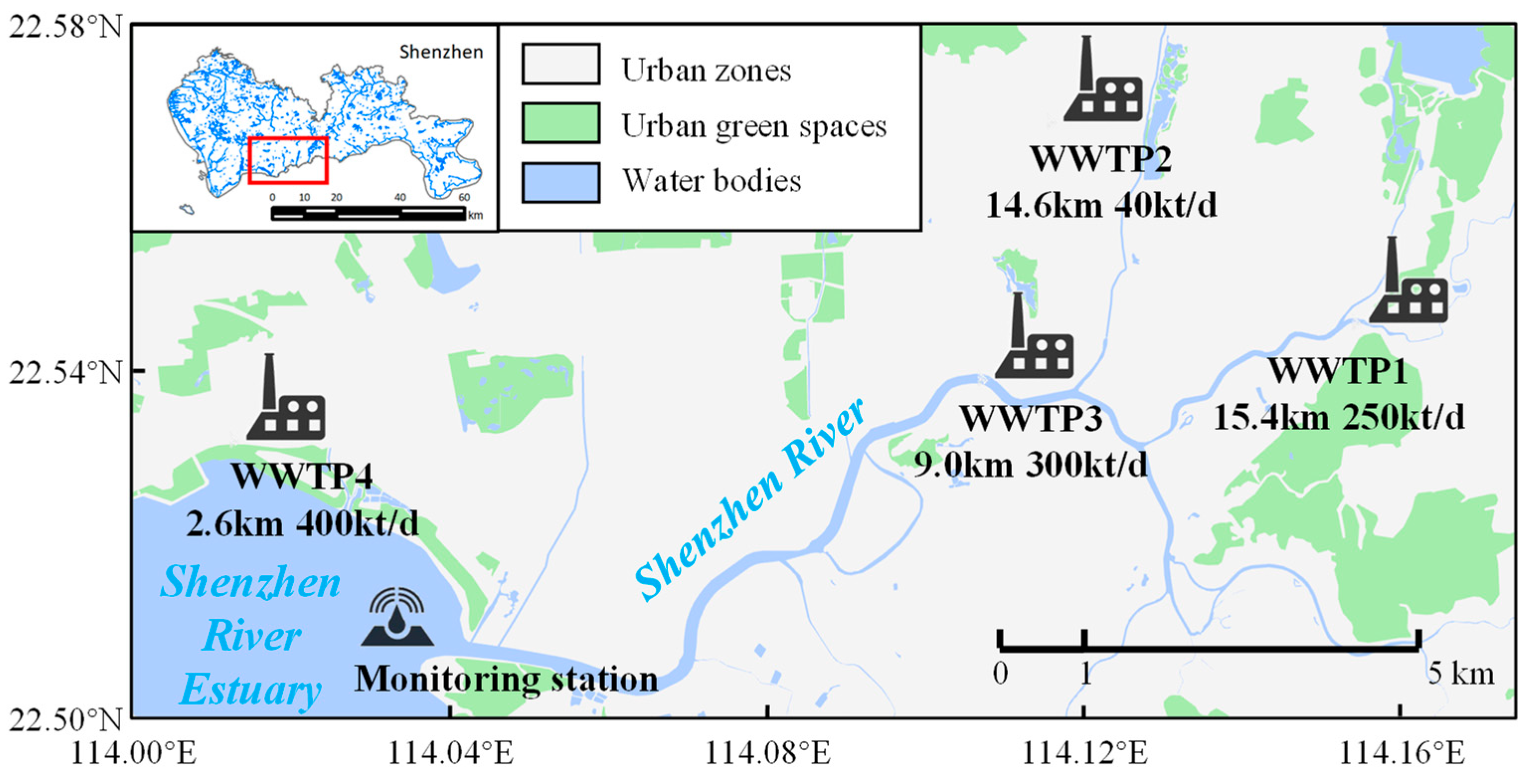
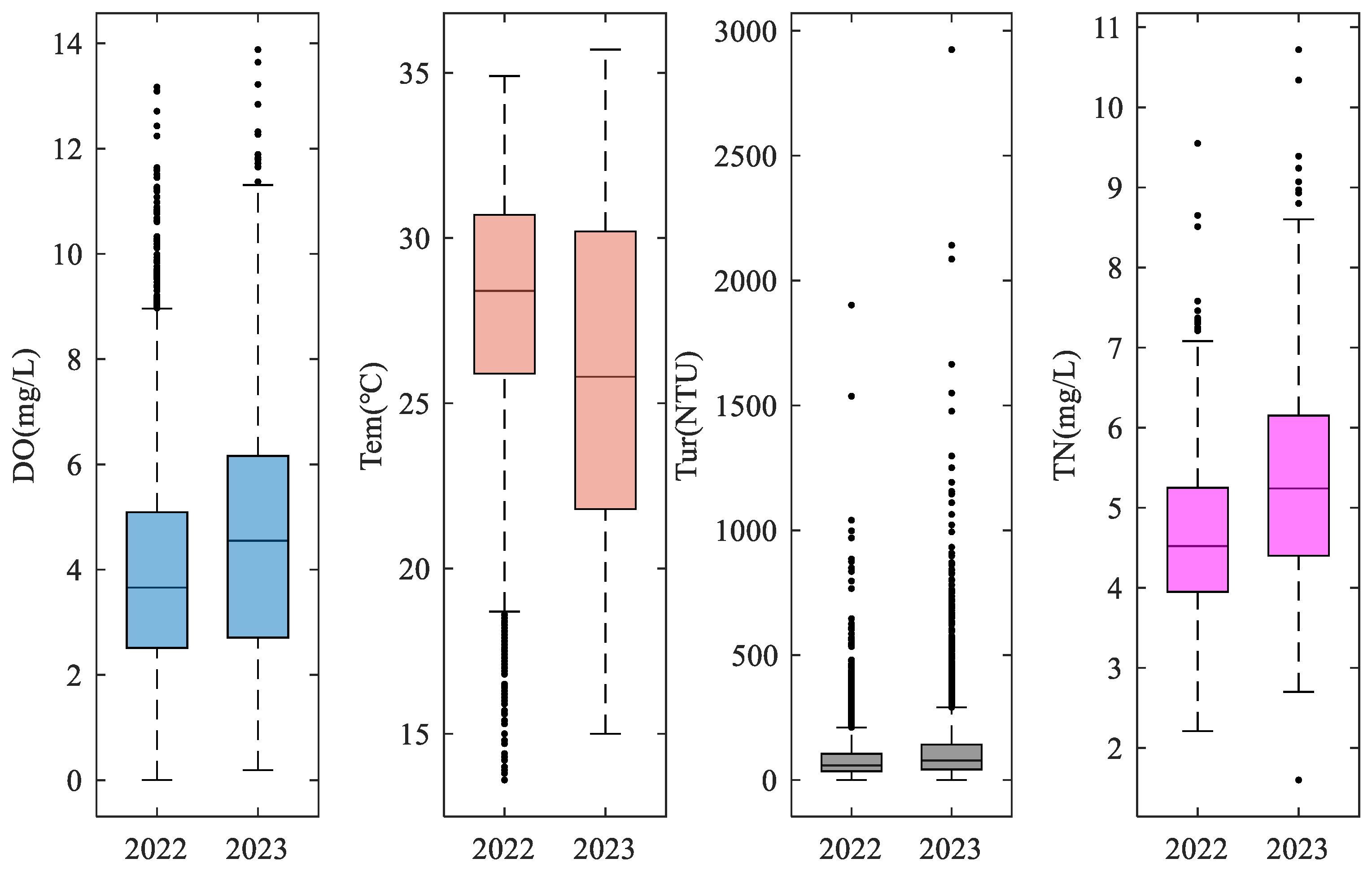
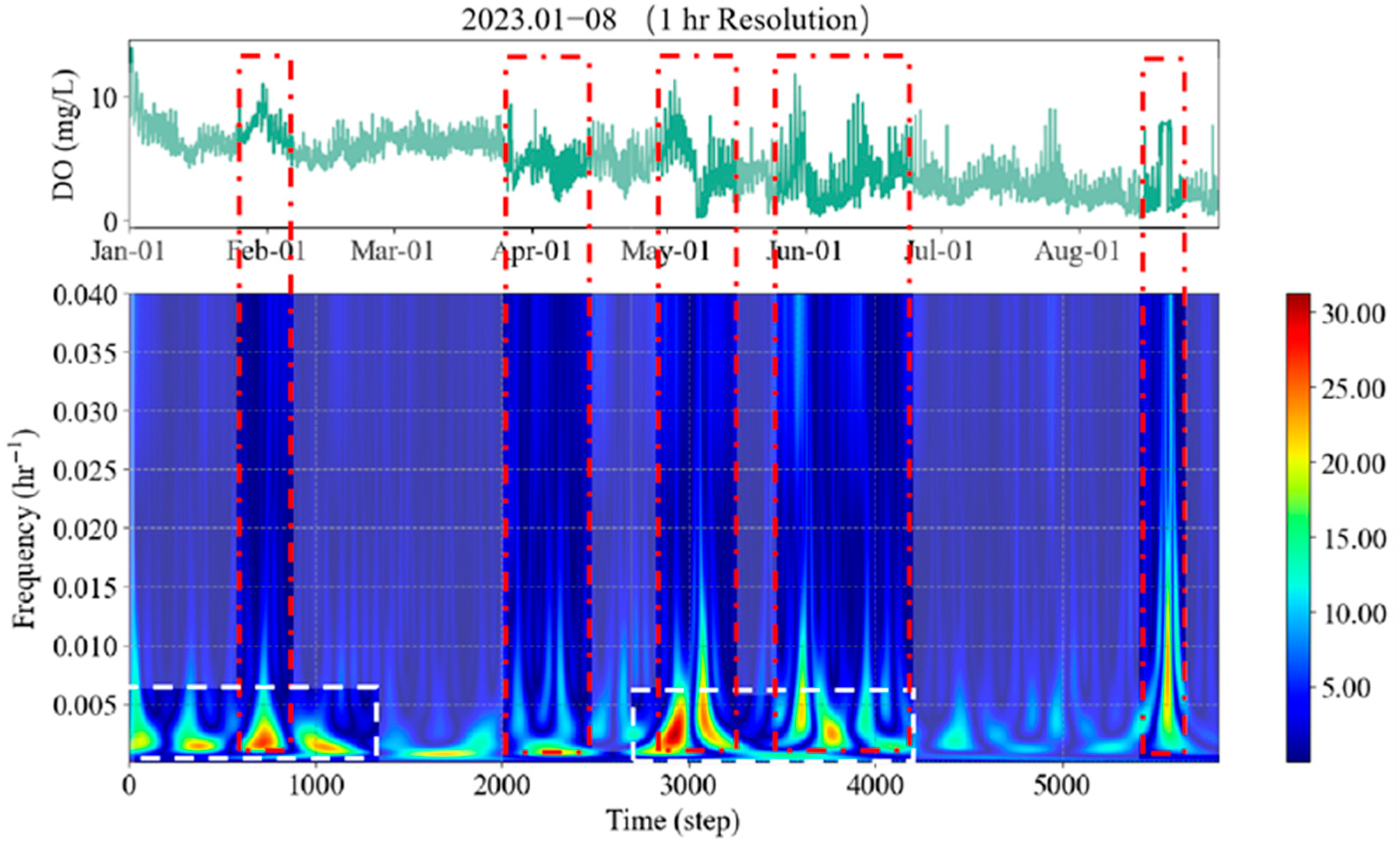
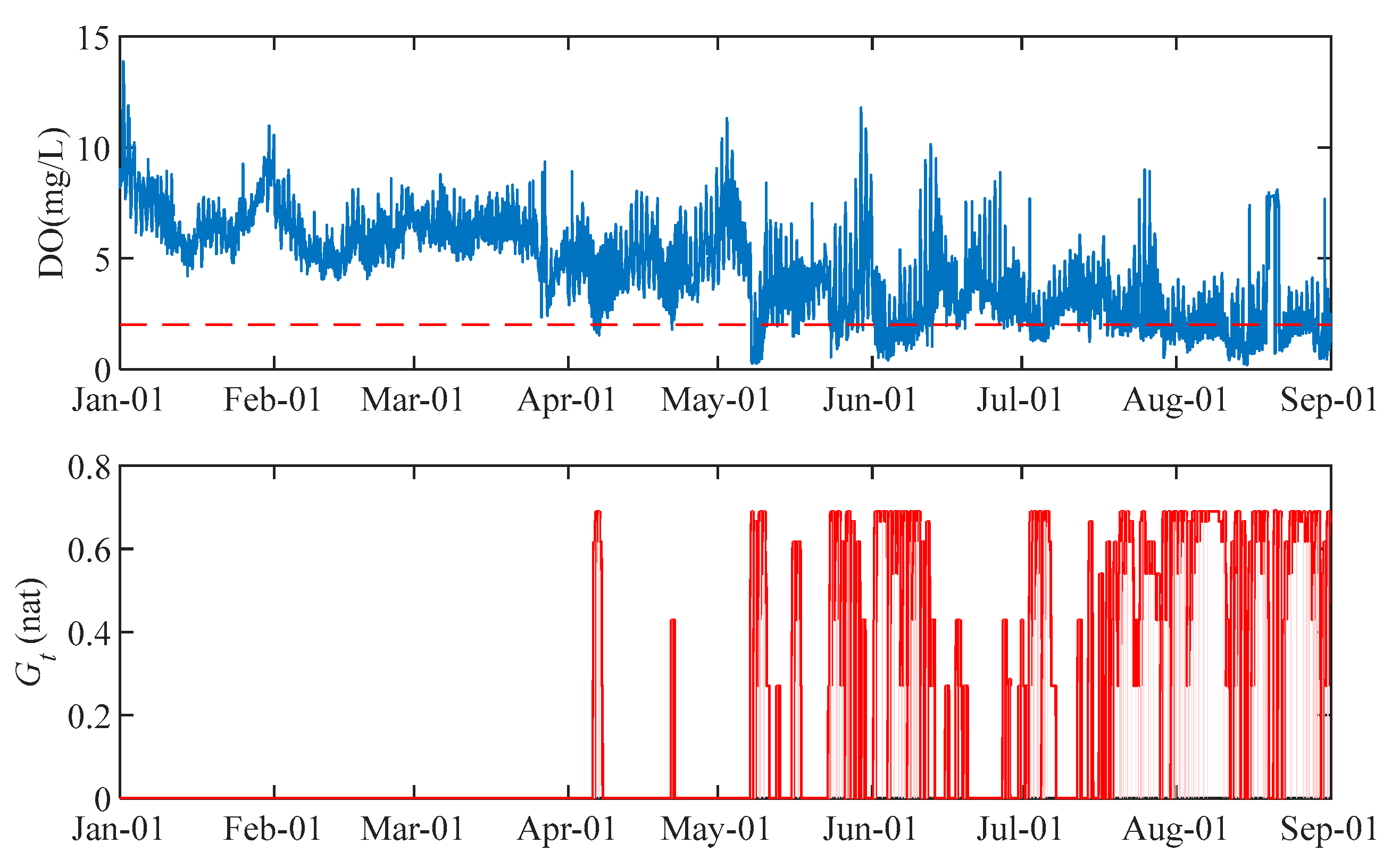

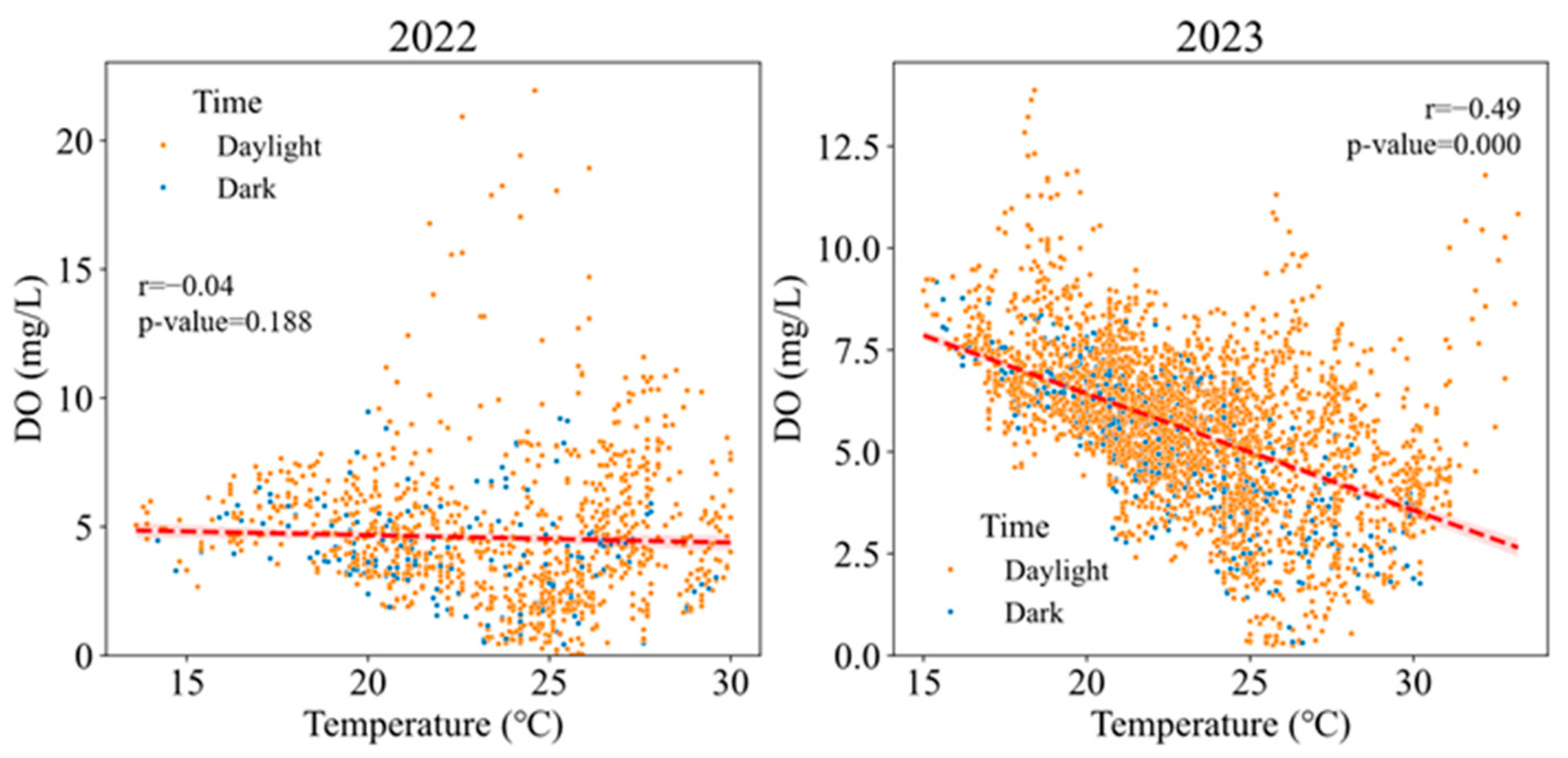
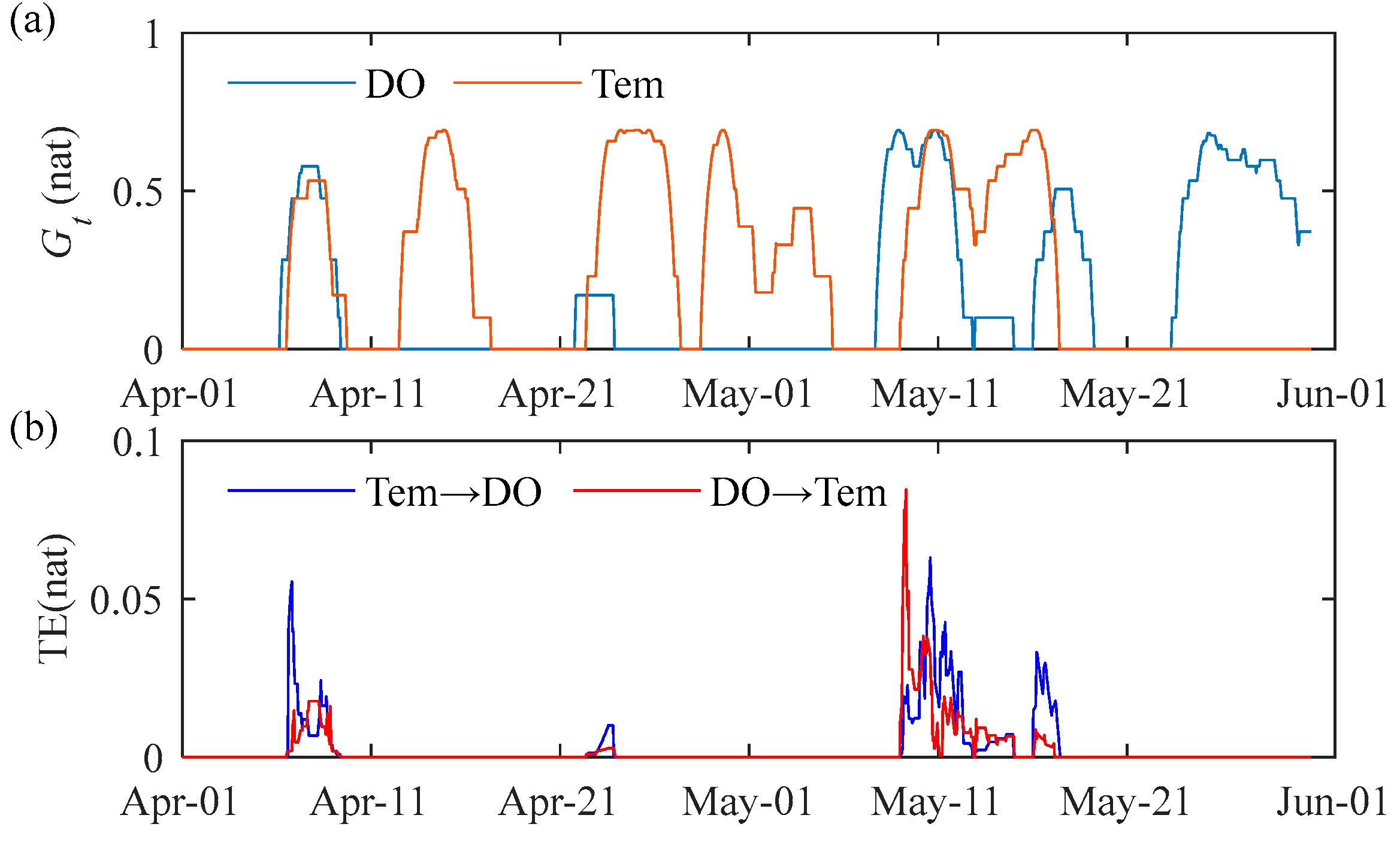
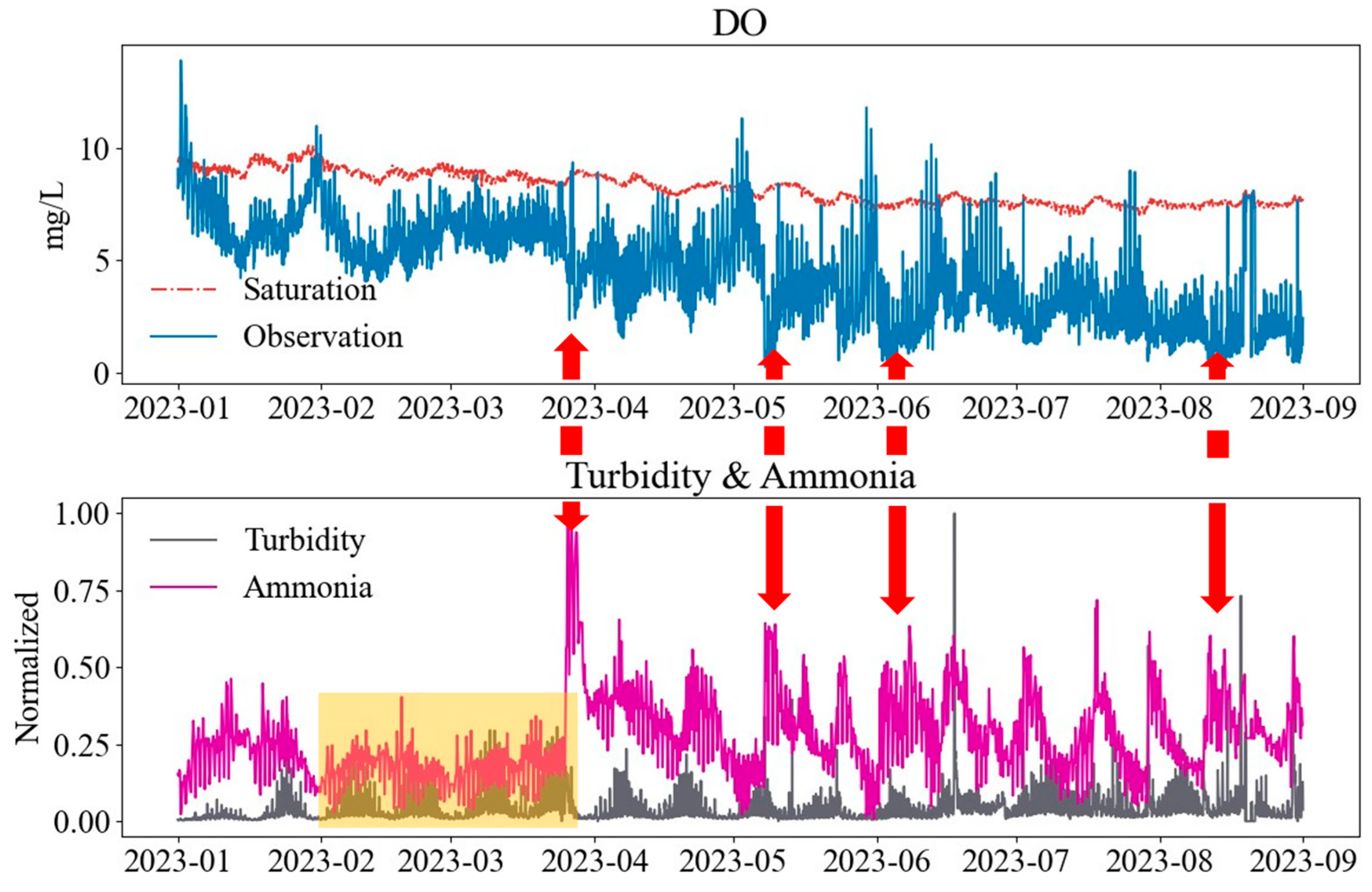
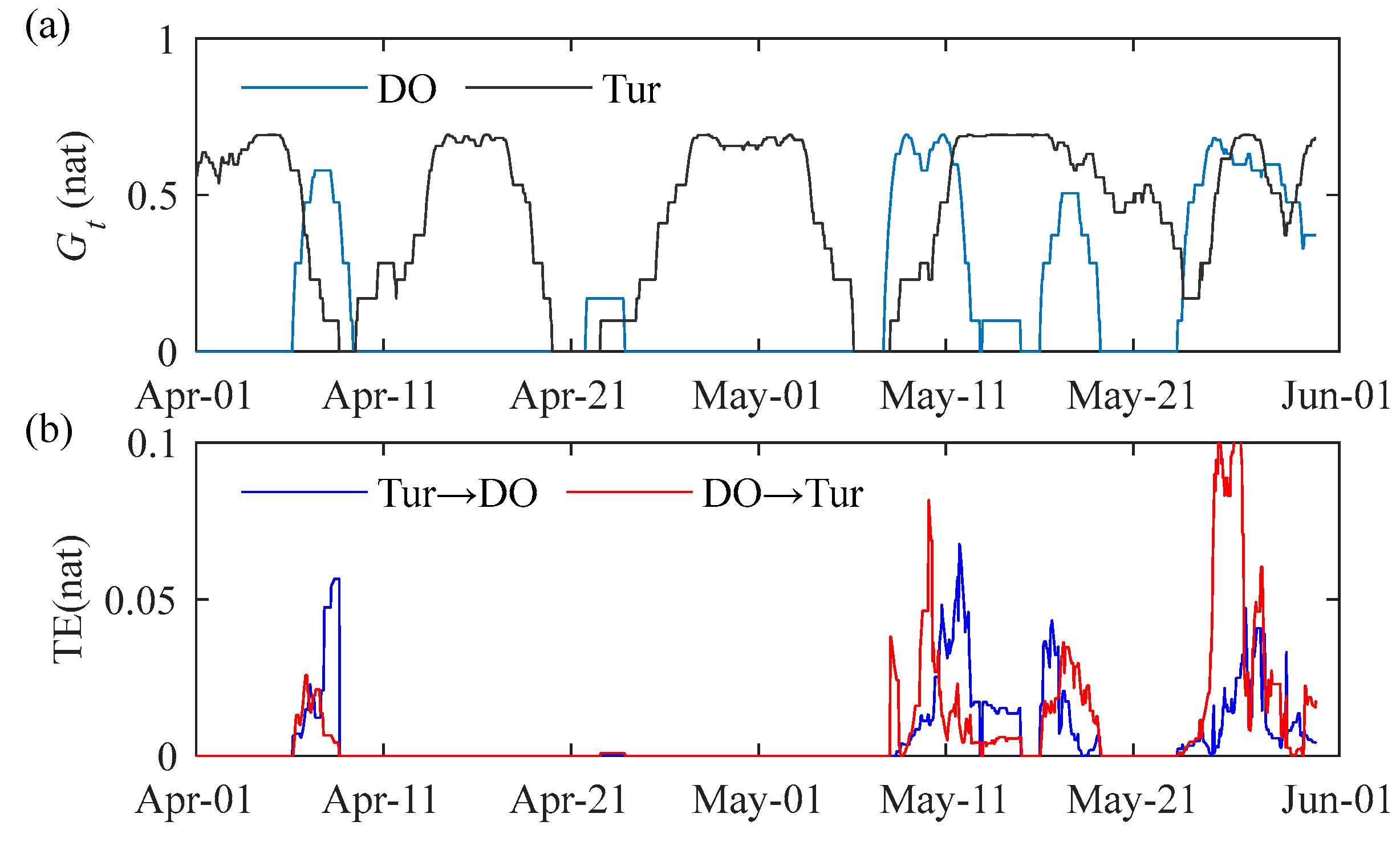
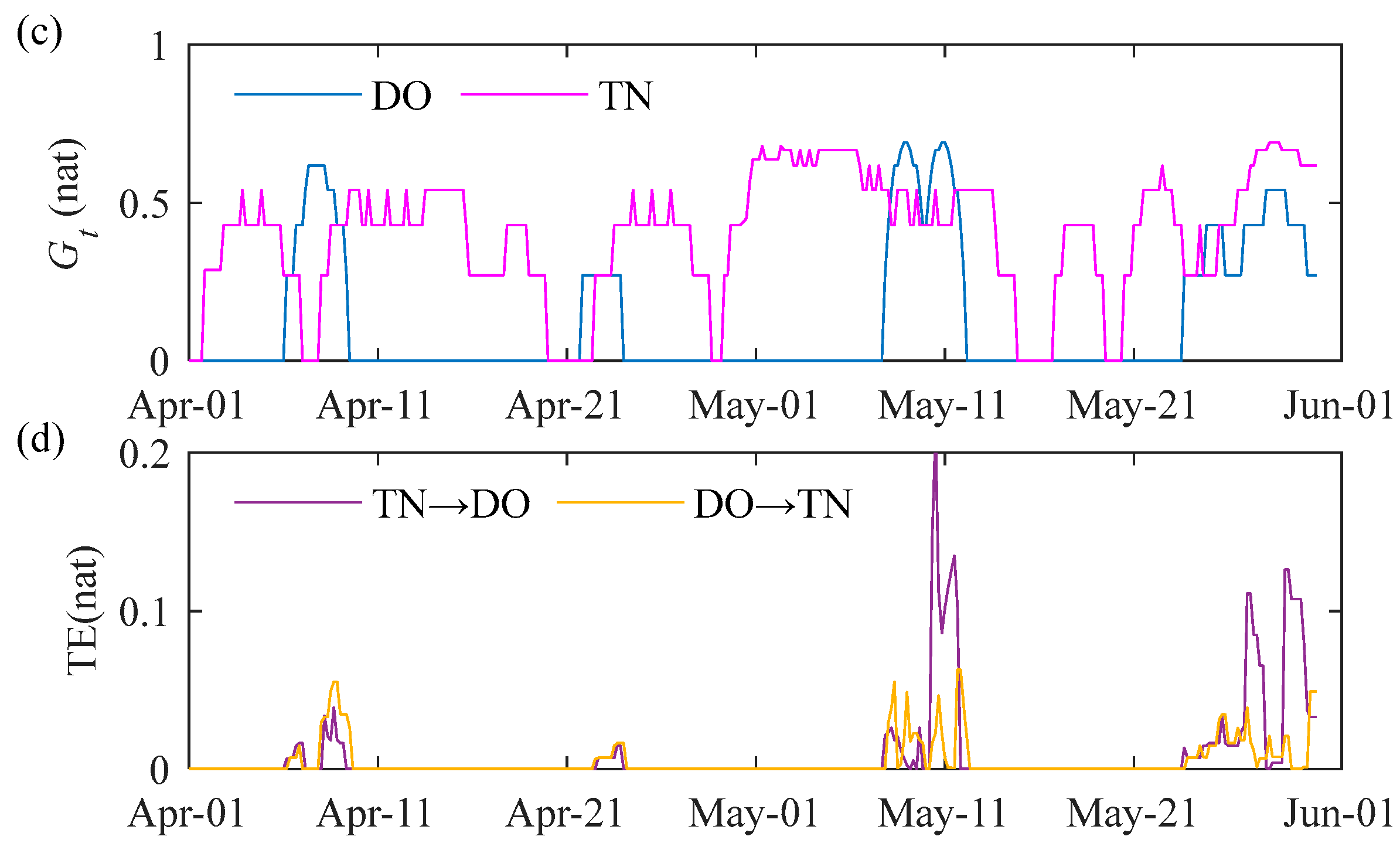

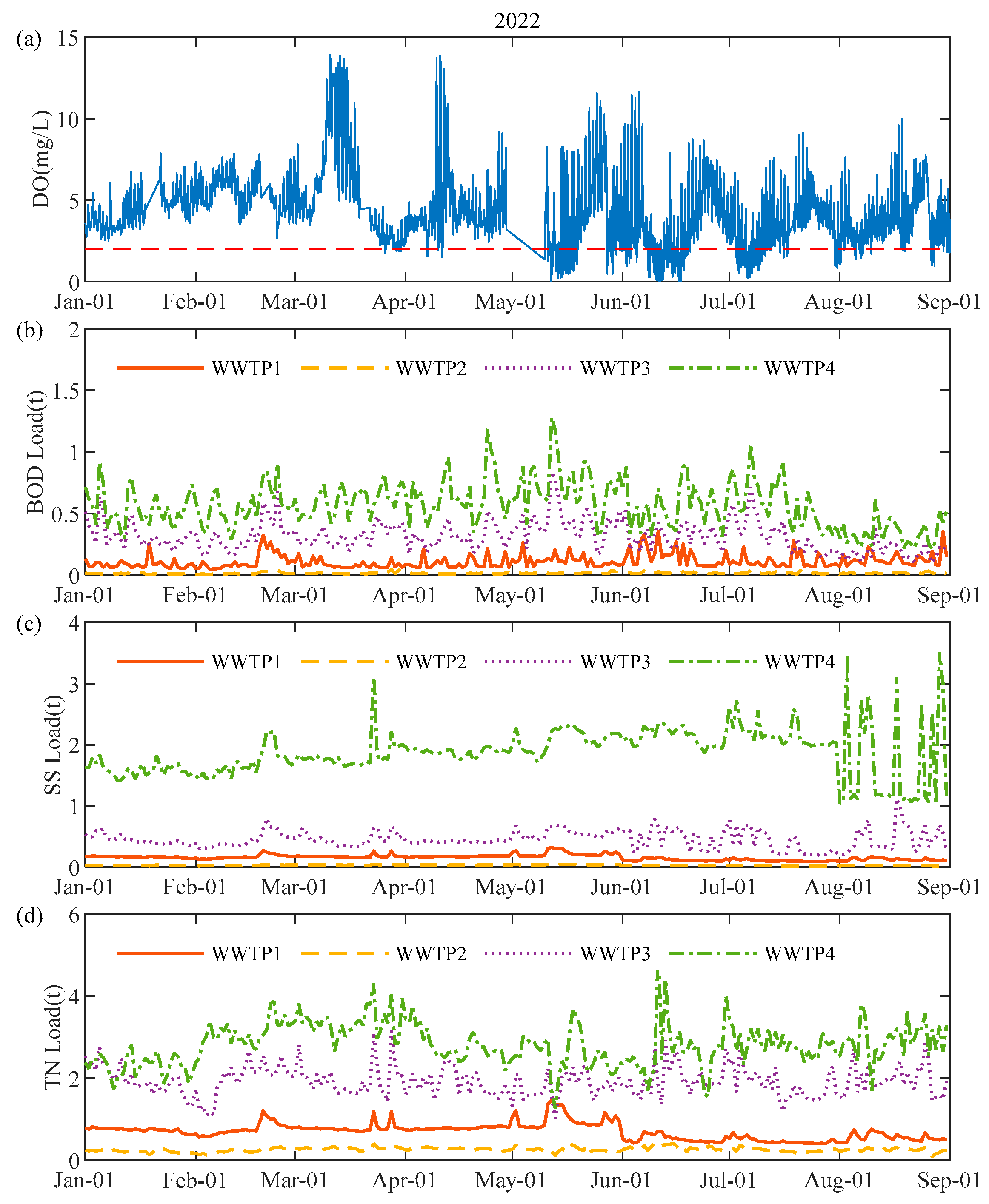

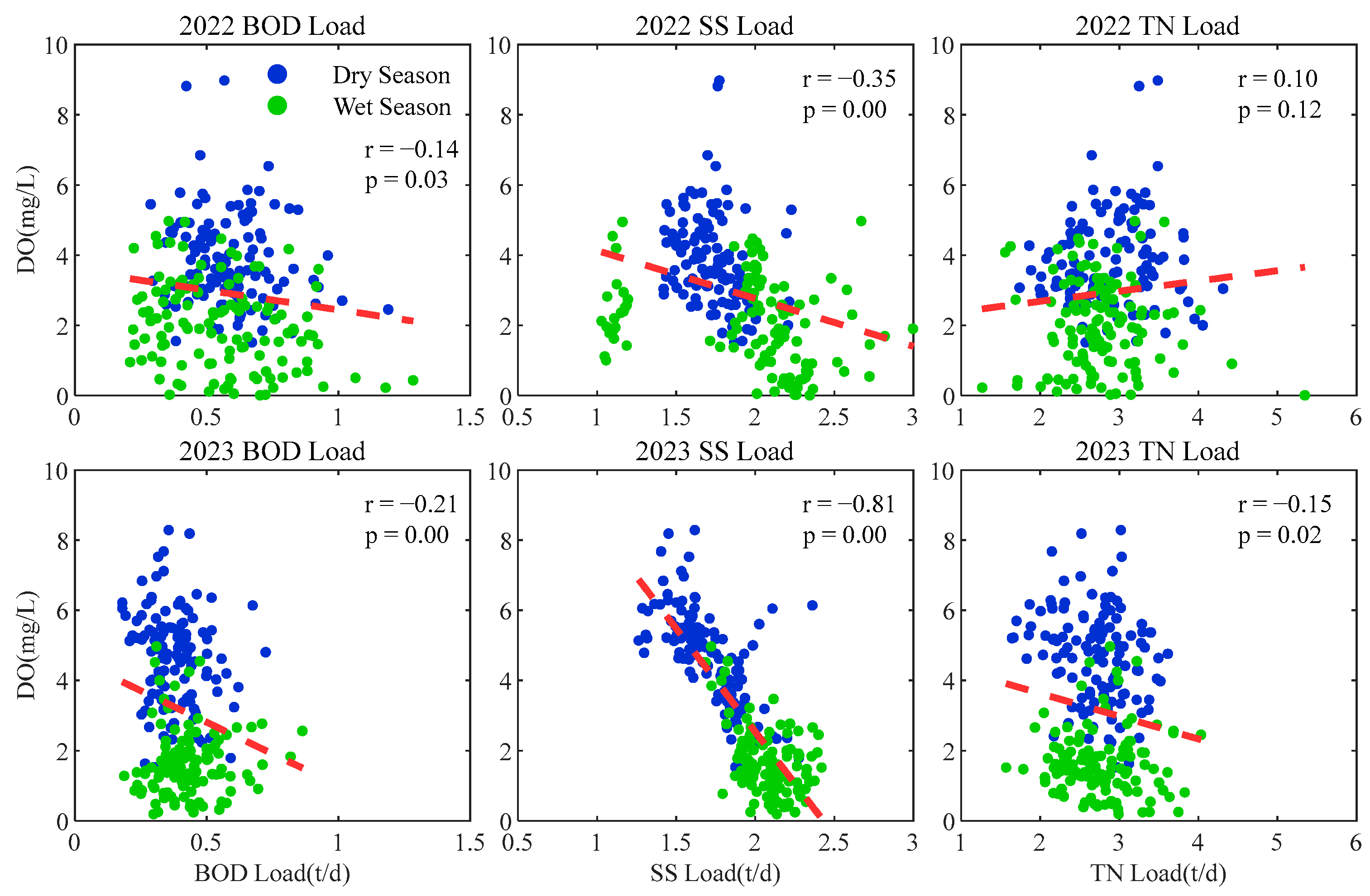
| Data Source | Parameter | Time Resolution |
|---|---|---|
| SRE monitoring station | Temperature | Every hour (after 10 May 2022); Every 4 h (before 29 April 2022) |
| DO | ||
| Turbidity | ||
| TN | Every 4 h | |
| WWTP outlet monitoring stations | WWTP treatment capacity | Daily |
| BOD | ||
| SS | ||
| TN |
| Coefficient | Explanation | Value |
|---|---|---|
| k1 | Degradation coefficient of BOD (d−1) | 0.25 |
| k2 | Degradation coefficient of SS (d−1) | 1 |
| k3 | Degradation coefficient of TN (d−1) | 0.15 |
| x1 | Distance from WWTP1 to the estuary (km) | 15.4 |
| x2 | Distance from WWTP2 to the estuary (km) | 14.6 |
| x3 | Distance from WWTP3 to the estuary (km) | 9 |
| u | Velocity of river flow (km/d) | 8.64 |
Disclaimer/Publisher’s Note: The statements, opinions and data contained in all publications are solely those of the individual author(s) and contributor(s) and not of MDPI and/or the editor(s). MDPI and/or the editor(s) disclaim responsibility for any injury to people or property resulting from any ideas, methods, instructions or products referred to in the content. |
© 2025 by the authors. Licensee MDPI, Basel, Switzerland. This article is an open access article distributed under the terms and conditions of the Creative Commons Attribution (CC BY) license (https://creativecommons.org/licenses/by/4.0/).
Share and Cite
Pang, T.; Zhang, X.; Xiong, Y.; Wang, H.; Chang, S.; Zheng, T.; Jiang, J. Detection and Driving Factor Analysis of Hypoxia in River Estuarine Zones by Entropy Methods. Water 2025, 17, 1862. https://doi.org/10.3390/w17131862
Pang T, Zhang X, Xiong Y, Wang H, Chang S, Zheng T, Jiang J. Detection and Driving Factor Analysis of Hypoxia in River Estuarine Zones by Entropy Methods. Water. 2025; 17(13):1862. https://doi.org/10.3390/w17131862
Chicago/Turabian StylePang, Tianrui, Xiaoyu Zhang, Ye Xiong, Hongjie Wang, Sheng Chang, Tong Zheng, and Jiping Jiang. 2025. "Detection and Driving Factor Analysis of Hypoxia in River Estuarine Zones by Entropy Methods" Water 17, no. 13: 1862. https://doi.org/10.3390/w17131862
APA StylePang, T., Zhang, X., Xiong, Y., Wang, H., Chang, S., Zheng, T., & Jiang, J. (2025). Detection and Driving Factor Analysis of Hypoxia in River Estuarine Zones by Entropy Methods. Water, 17(13), 1862. https://doi.org/10.3390/w17131862






